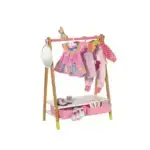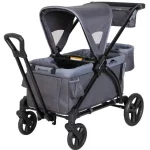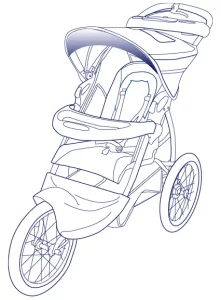
Read all instructions BEFORE assembly and USE of product.
KEEP INSTRUCTIONS FOR FUTURE USE.

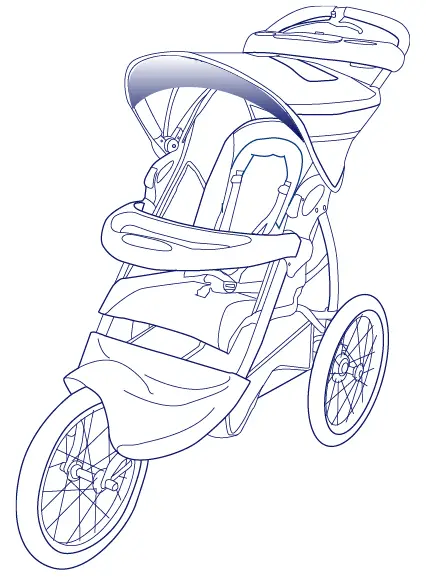 Model # 9134
Model # 9134
US Patent # 6196571, DES.430826
Expedition LX Jogging Stroller
Instruction Manual
Convenience through Innovation and thoughtful design
 Expedition LX Jogging Stroller
Expedition LX Jogging Stroller
 WARNING: Please follow all of these instructions to ensure the safety of your child. Keep these instructions for future reference.
WARNING: Please follow all of these instructions to ensure the safety of your child. Keep these instructions for future reference.
 WARNING: Failure to follow these instructions could result in serious injury or death. Avoid serious injury from falling or sliding out. Always use the safety harness and insure that the child is properly positioned according to these instructions.
WARNING: Failure to follow these instructions could result in serious injury or death. Avoid serious injury from falling or sliding out. Always use the safety harness and insure that the child is properly positioned according to these instructions.
 WARNING: Never leave child unattended.
WARNING: Never leave child unattended.
- Purses, shopping bags, parcels, diaper bags or accessory items may change the balance of the stroller and cause hazardous unstable conditions.
- The maximum weight that can be carried in the basket is 5 lbs and in the parent tray is 3 lbs. Excessive weight may cause a hazardous unstable condition to exist.
- Be certain the stroller is fully erect and latched in the open position before allowing the child near the stroller.
- Use of the stroller with a child weighing more than 50 pounds, or over 42 inches tall, will cause excessive wear and stress on the stroller and may cause a hazardous unstable condition to exist.
- DO NOT use the stroller on stairways or escalators.
- DO NOT use the stroller with roller skates or in-line skates.
- We recommend that the child occupant be at least 6 months of age prior to use of the stroller for jogging.
Because children develop at different rates, please discuss the use of a jogging stroller with your health care provider prior to jogging with your child. - Never allow your stroller to be used as a toy
- To clean use only mild household soap or detergent and warm water on a sponge or clean cloth.
- Check your stroller for loose screws, worn parts, torn material or stitching on a regular basis. Replace or repair parts as needed.
- Discontinue use of stroller should it malfunction or become damaged. Please contact our customer service Parts Hotline to arrange for repair or obtain replacement parts.
Please: If you experience any difficulty with the use of our product or have a question regarding these instructions, please contact our Customer Service Department at (800) 328-7363 between the hours of 8:00 a.m. and 4:30 p.m. Pacific Coast Time. Please do not return the product to the store as once it is returned it cannot be re-sold and the materials and energy used to make it are wasted.
To contact us:
BABY TREND, INC.
1567 S. Campus Ave.
Ontario, CA 91761
Parts Hotline:
(800) 328-7363
8:00 a.m. to 4:30 p.m. Pacific Coast Time
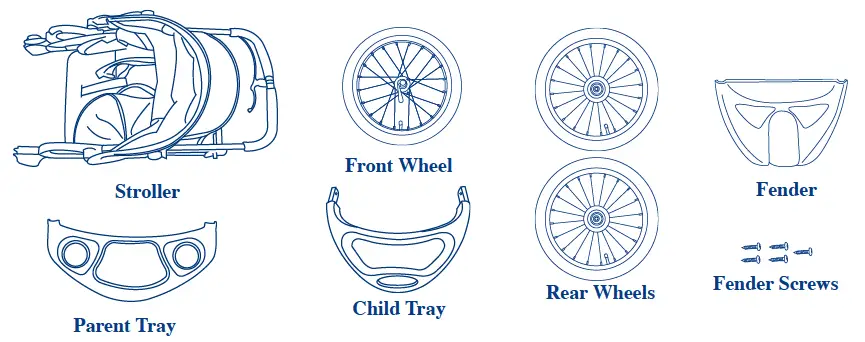
 TO ENSURE SAFE OPERATION OF YOUR STROLLER, PLEASE FOLLOW THESE INSTRUCTIONS CAREFULLY. ETAIN THESE INSTRUCTIONS FOR FUTURE REFERENCE.
TO ENSURE SAFE OPERATION OF YOUR STROLLER, PLEASE FOLLOW THESE INSTRUCTIONS CAREFULLY. ETAIN THESE INSTRUCTIONS FOR FUTURE REFERENCE.
ASSEMBLY:
- Remove stroller from box. The front wheel, rear wheels, fender, child tray and parent tray need to be installed prior to use.
- To attach the front wheel, unfold stroller as described in the section following. See figure 1.
Lean the stroller backward so that it rests on the handle and rear axle frame and the front wheel forks are pointing upward.
The front-wheel features a quick-release attachment system. See figure 3. Slide the front wheel onto the front forks. See figure 2. The quick-release must be loose enough for the wheel to slide on and the brake release lever must be in the open position (see figure 6). Line up the tab on the Holding Plate with the slot on the fork plate. With the wheel in position, tighten the finger nut on the axle until it is very close to contacting the fork. See figure 4. Rotate the lever to the closed position as shown in figure 5. You should feel significant resistance when closing the lever and the wheel should be held tightly. If you do not, open the lever and tighten the finger nut a bit more and close the lever again. Continue to do this until the wheel is held tightly in the fork. Close the brake release lever by rotating it toward the front of the stroller. See figure 6. - The front fender is secured to the frame by the 5 screws provided. Examine the bottom of the front fender. You will notice four 1/4 inch diameter plastic tubes protruding from the bottom. See figure 7a. These tubes must be lined up with the holes in the front frame assembly. See figure 7b. Line up the front fender and press onto the front frame assembly. See figure 7c. Insert the 5 screws through the underside of the front frame assembly into the front fender’s plastic tubes. Tighten the screws only until snug. See figure 7d.
Do Not over-tighten.
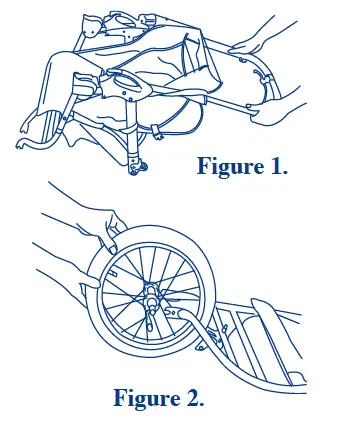
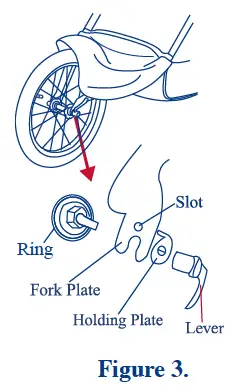
- Lean the stroller forward to rest on the front wheel. To attach the rear wheels, push each wheel’s axle into the plastic corner fitting as shown in figure 8. Lift upward on the plastic lever on the inside of the corner fitting as you push the axle into corner fitting. When the wheel will not go on any farther, release the lever. Check that the wheel has locked into the corner fitting by pulling on the wheel. If not locked, lift upward on the lever, push the wheel on farther and release lever.
Ensure that the wheels are firmly locked into place. Do Not use the stroller if the wheels are not locked into place, but rather contact our customer service department immediately at (800) 328-7363, between the hours of 8:00am and 4:30pm PCT, for assistance - To attach the front child tray, line up the male fittings of the child tray with the female fitting on the outside of the center joint and push inward (toward the rear of the stroller) until locked in place. See figure 9A. To remove the front child tray, depress the button on the underside of the male fitting and pull the tray outward to remove. See figure 9B
- To attach the parent tray, align the fittings on the ends of the parent tray with the fittings on the outsides of the handle. Hook one end of the tray on so that the fitting on the handle protrudes from the hole in the parent tray. Pull outward on the opposite end while pushing down on the tray until locked onto the stroller handle. Please be careful not to pinch your finger when installing the parent tray. Please see figure 9C. To remove the parent tray, pull outward on one end of the tray while lifting upward.
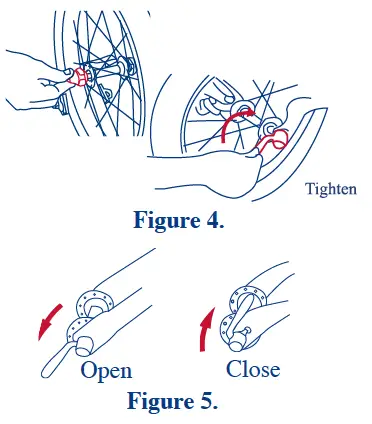
 :
: - To open the canopy, push forward on the front edge of the canopy while holding the rear of canopy in place. Please see figure 10.
- To fold the canopy, pull backwards on the front edge. Please see figure 11. The canopy must be in the closed position before folding the stroller. Your stroller is now ready to use
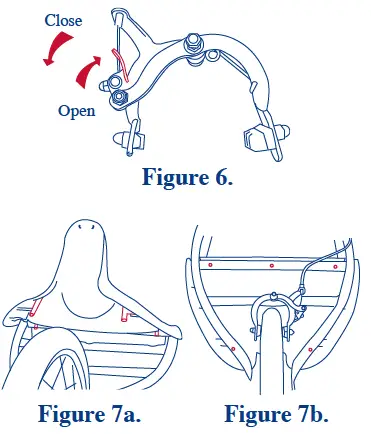
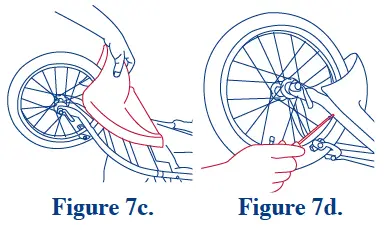
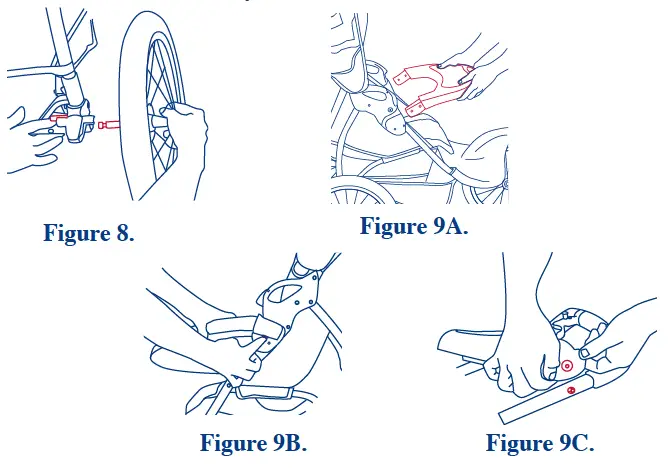
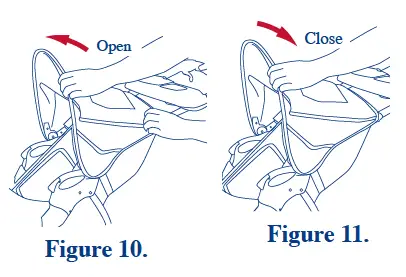
TO SECURE THE CHILD - The shoulder straps of the 5-point harness have 2 attachment positions. Select the position that places the shoulder strap level with, or below the top of the child’s shoulder.
- Carefully place the child in the stroller seat and bring the safety harness around the child’s waist and over the shoulders. Place the crotch strap between the child’s legs. Insert the male end of each shoulder/waist belt into the buckle on the crotch strap. Tighten the harness to be snug around the child’s waist and over the child’s shoulders Please see figure 12a.
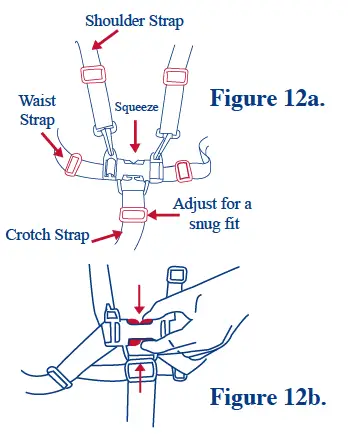
 WARNING: Avoid serious injury from falling or sliding out. Always use the safety harness.
WARNING: Avoid serious injury from falling or sliding out. Always use the safety harness.
 STRANGULATION HAZARD:
STRANGULATION HAZARD:
Child can strangle in loose straps. Never leave child in seat when straps are loose or undone. - To release, apply pressure to both sides of each male clip until the clip is released. See figure 12b. This process requires a moderate amount of effort so as to prevent an accidental release by your child. The jogging stroller also comes with a removeable head support, attached by 2 hook and loop fasteners. See figure 12c.
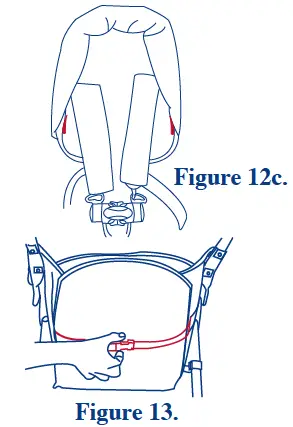
SEATBACK POSITIONING - The seat has a multiple position recline that is controlled by a strap and buckle assembly behind the seat. See figure 13. To recline the seat, loosen the strap through the buckle and adjust to the required recline position. Please see figure 14. To place the seat back in a more upright position, press upward on the seat back with one hand while pulling the strap through the buckle with the other. The strap will lock automatically. The upright position should be used only for a child that is at least 6 months old. Always re-adjust the safety harness, including the shoulder belts, when repositioning the seatback.
BRAKES
 WARNING: Always set brakes when the stroller is not being pushed so that the stroller will not roll away. Never leave stroller unattended on a hill or incline as the stroller may slide down the hill.
WARNING: Always set brakes when the stroller is not being pushed so that the stroller will not roll away. Never leave stroller unattended on a hill or incline as the stroller may slide down the hill. - To engage brakes, apply light downward pressure to the brake lever located on each rear wheel. The stroller may require slight forward or rearward movement in order to line up the teeth on the brake with each wheel brake cluster. See figure 15. Check that the stroller will not move and that both brakes are properly applied. To release, gently lift up on the brake lever.
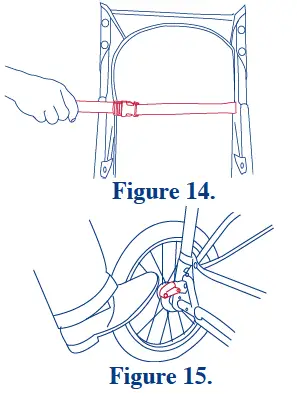
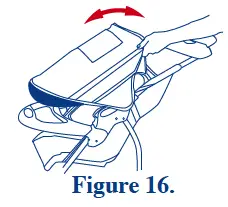 CANOPY
CANOPY - The canopy features a ratchet system that allows the canopy to be moved forward or back to block the sun or wind. To adjust the canopyʼs position, push forward or backward on the canopy until the canopy is in the desired position. See figure 16.
JOGGING WITH YOUR STROLLER
Your jogging stroller has two safety features for use when you are jogging with your child: - Always connect the safety strap to either wrist when jogging. This strap will keep the stroller from rolling away in the event that you trip while running. See figure 17. The safety strap must remain connected to the rear lower frame cross member at all times. This location is intended to prevent the stroller being tipped backward in the event that you do fall to the ground. The safety strap includes a Velcro attachment for storage, on the left side of the stroller, when not in use. See figure 18.
- The front wheel has a bicycle style caliper brake system that is designed to assist you in slowing the stroller on a hill or in the event of an emergency. Squeeze the brake handle to slow the stroller. See figure 19. The hand brake is not to be used as a parking brake. Please see brake section.
TO FOLD STROLLER: - Close the canopy as described in the canopy section above. Recline seat by releasing buckle as described in seatback positioning section above.
- The stroller is folded by simultaneously depressing the safety lock on the right side and fold buttons located on the central joints. Please see figure 20. When the fold latches are released, the handle will begin to fall toward the floor. Release the fold buttons and press downward on the stroller handle until the stroller is completely folded. Secure the stroller in the folded position by hooking the fold latch, located on the right side of the stroller, over the rivet that protrudes from the frame. See figure 21.
TO UNFOLD STROLLER: - Stand the stroller on the ground with all three wheels touching the ground. Release the folding latch, which is located on the right side.
See figure 22. - Lift up on the stroller handle with both hands until the stroller frame is erect and locked in the open position. See figure 23. The stroller has spring-loaded latches on both sides of the frame. Test that both latches are fully engaged prior to placing your child in the stroller.
TIRES: - Tires are shipped un-inflated. The tires should be inflated on a regular basis to between 20 to 25 pounds of air pressure. Always use a bicycle
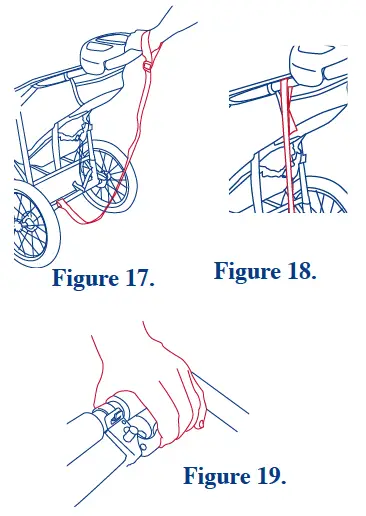
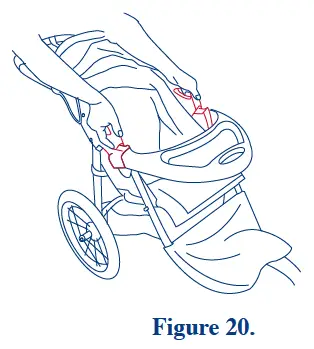
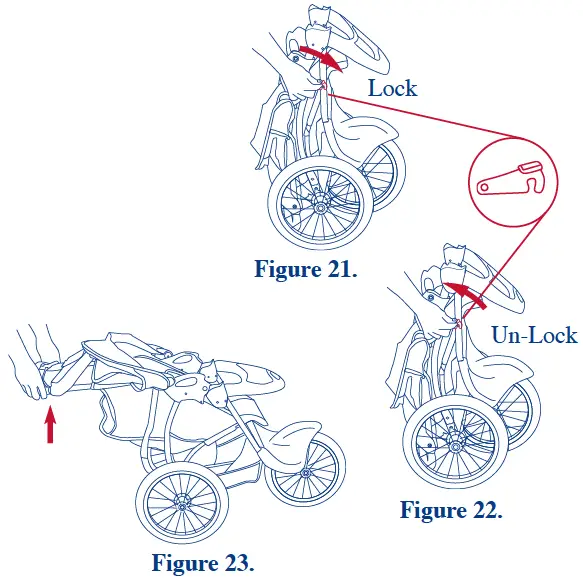
 Stroller pulls to one side:
Stroller pulls to one side:
The jogging stroller is unusual in that it has no swiveling front wheels. Therefore, the stroller may at times feel like it is pulling to one side. This problem can have two different causes, either individually or in combination. Please perform the following steps in their numbered order.
- The stroller is sensitive to the air pressure in the tires. If the rear tires do not have equal pressure, the stroller will feel like it is pulling to the side with the tire with the lower tire pressure. Check that the rear tires have the same pressure. Add air pressure to a maximum of 25 pounds using a bicycle style hand air pump.
- The alignment of the front wheel of the stroller can also cause the stroller to pull to one side. The stroller is designed so that the front wheel can be adjusted to correct for any alignment problem. Page 3 of the instruc- tions shows an expanded view of the front fork assembly. To align the front wheel, first loosen the wheel via the quick release handle as in step 2 of the instructions. Grab the front wheel directly in front of the stroller and push the wheel in the opposite direction of the pulling problem. You will notice that the axle will move within the slot on the fork. Move the wheel to the side a small amount. Retighten the quick release handle. Give the empty stroller a push across an empty smooth surface (let go of the handle) and note if the stroller now runs straight. Re-adjust the axle a small amount at a time until the stroller runs straight. Please note that a very min- ute movement of the axle will affect the tracking of the stroller. Once you have aligned the front wheel, you can mark the holding plate position with a marking pen if you detach the front wheel on a regular basis. Please note that the hole in the fork is designed to allow the stroller to be adjusted to pull to the right, go straight, or pull to the left. If you continue to have difficulty with tracking, please call our customer service department at (800) 328-7363 for assistance.
Caliper Brake does not slow the stroller down: Reverse steps if brakes are too tight
The jogging stroller is equipped with a bicycle-style caliper brake to assist you in slowing the stroller. It is de-signed with a quick-release lever for ease in detaching the front wheel of the stroller. If you are experiencing inadequate slowing when applying the hand brake, please review the drawing below in the instruction manual to ensure that the quick-release lever is in the down position (i.e. facing the front of the stroller). If the quick-release lever is in the closed position and you are still experiencing a braking problem, the brake cable tension needs to be adjusted. This is accomplished in two different ways. If the brake is slowing the stroller slightly, the cable tension can be fine tuned via the tension nut located on the end of the brake cable just above the caliper. Turn the tension nut counter clockwise to increase tension. If at the maximum adjustment of the tension nut you still do not have adequate braking, you will need to adjust the length of the brake cable. To adjust the length of the cable, first return the tension nut to its factory setting by turning it clockwise until it stops. Loosen the cable clamp nut that holds the brake cable to the brake caliper. Squeeze the caliper together so that the brake pads are just touching the rim of the front wheel. Pull the cable through the cable clamp nut until the slack is removed. Retighten the cable clamp nut. Retest the braking and fine tune the tension via the tension nut until adequate slowing is achieved.
Please keep in mind that the brakes are designed to be adjustable in order to compensate for the wearing of the brake pads over time. If you experience difficulty, please call our customer service department at (800) 328-7363 for assistance. Also, most bicycle shops can quickly perform this adjustment for you.
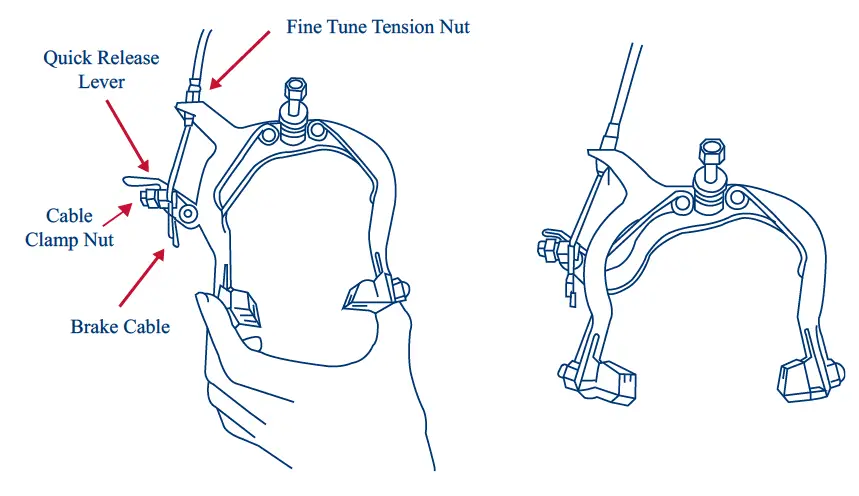
Flat tire:
The jogging stroller features bicycle tires to allow for extended wear and ease of pushing. Just like a bicycle tire, the jogging stroller can suffer from flat tires. If you have a flat tire, you can use a standard bicycle tire repair kit to repair the tire or you can take the tire to a bicycle shop for repair. If you experience numerous flat tires, you may want to purchase thorn proof inner tubes for the jogging stroller. These can be purchased at bicycle stores or at many national retail stores. The correct size to purchase is shown on the sidewall of the tire.
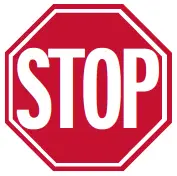
style hand air pump to inflate the tires.
IF YOU EXPERIENCE ANY DIFFICULTY IN USING THIS PRODUCT,
PLEASE CONTACT OUR CUSTOMER SERVICE DEPARTMENT AT
(800) 328-7363 BETWEEN THE HOURS OF 8:00 A.M. AND 4:30 P.M. PACIFIC COAST TIME
FOR ASSISTANCE. PLEASE HAVE YOUR MODEL NUMBER AND MANUFACTURING
DATE AVAILABLE WHEN YOU CALL. THIS INFORMATION CAN BE FOUND ON A SMALL
STICKER ON THE INSIDE OF THE STROLLER FRAME.
